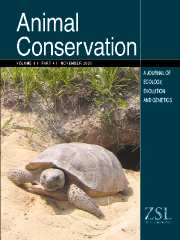Crossref Citations
This article has been cited by the following publications. This list is generated based on data provided by
Crossref.
Winterrowd, Michael F.
Gergits, William F.
Laves, Kevin S.
and
Weigl, Peter D.
2005.
RELATEDNESS WITHIN NEST GROUPS OF THE SOUTHERN FLYING SQUIRREL USING MICROSATELLITE AND DISCRIMINANT FUNCTION ANALYSES.
Journal of Mammalogy,
Vol. 86,
Issue. 4,
p.
841.
Fokidis, H. Bobby
and
Risch, Thomas S.
2005.
The Use of Nest Boxes to Sample Arboreal Vertebrates.
Southeastern Naturalist,
Vol. 4,
Issue. 3,
p.
447.
MITCHELL, LEE R.
CHANDLER, C. RAY
CARLILE, LAWRENCE D.
and
Martin
2005.
RESEARCH NOTES: HABITAT AS A PREDICTOR OF SOUTHERN FLYING SQUIRREL ABUNDANCE IN RED-COCKADED WOODPECKER CAVITY CLUSTERS.
Journal of Wildlife Management,
Vol. 69,
Issue. 1,
p.
418.
BORGO, JENNIFER S.
CONOVER, MICHAEL R.
and
CONNER, L. MIKE
2006.
Nest Boxes Reduce Flying Squirrel Use of Red-Cockaded Woodpecker Cavities.
Wildlife Society Bulletin,
Vol. 34,
Issue. 1,
p.
171.
Costa, Ralph
and
DeLotelle, Roy S.
2006.
The Longleaf Pine Ecosystem.
p.
335.
Winterrowd, Michael F.
and
Weigl, Peter D.
2006.
Mechanisms of Cache Retrieval in the Group Nesting Southern Flying Squirrel (Glaucomys volans).
Ethology,
Vol. 112,
Issue. 11,
p.
1136.
LAVES, KEVIN S.
and
LOEB, SUSAN C.
2006.
Differential Estimates of Southern Flying Squirrel (Glaucomys volans) Population Structure Based on Capture Method.
The American Midland Naturalist,
Vol. 155,
Issue. 1,
p.
237.
Delaney, David K.
Pater, Larry L.
Carlile, Lawrence D.
Stevenson, Dirk J.
and
Walde, Andrew D.
2008.
Red-cockaded Woodpecker (Picoides borealis) Response to Nest Depredation by an Eastern Rat Snake (Elaphe alleghaniensis).
Southeastern Naturalist,
Vol. 7,
Issue. 4,
p.
753.
KAPPES, JOHN J.
and
DAVIS, JOHN M.
2008.
EVIDENCE OF POSITIVE INDIRECT EFFECTS WITHIN A COMMUNITY OF CAVITY-NESTING VERTEBRATES.
The Condor,
Vol. 110,
Issue. 3,
p.
441.
Perkins, Micah W.
Conner, L. Mike
and
Brent Howze, M.
2008.
The importance of hardwood trees in the longleaf pine forest ecosystem for Sherman's fox squirrels.
Forest Ecology and Management,
Vol. 255,
Issue. 5-6,
p.
1618.
Kappes, John J.
2008.
Cavity Number and Use by Other Species as Correlates of Group Size in Red-Cockaded Woodpeckers.
The Wilson Journal of Ornithology,
Vol. 120,
Issue. 1,
p.
181.
Craig Rudolph, D.
Schaefer, Richard R.
and
Pierce, Josh B.
2009.
Texas Ratsnake Predation on Southern Flying Squirrels in Red-Cockaded Woodpecker Cavities.
Southeastern Naturalist,
Vol. 8,
Issue. 2,
p.
41.
Borgo, Jennifer S.
Conover, Michael R.
and
Conner, L. Michael
2010.
Flying Squirrel Removal Does Not Reduce Their use of Simulated Red-Cockaded Woodpecker Nest Clusters.
Southeastern Naturalist,
Vol. 9,
Issue. 4,
p.
813.
WALTERS, ERIC L.
and
JAMES, FRANCES C.
2010.
Quantifying Purported Competition with Individual‐ and Population‐Level Metrics.
Conservation Biology,
Vol. 24,
Issue. 6,
p.
1569.
Kappes, John J.
and
Sieving, Kathryn E.
2011.
Resin-Barrier Maintenance as a Mechanism of Differential Predation Among Occupants of Red-Cockaded Woodpecker Cavities.
The Condor,
Vol. 113,
Issue. 2,
p.
362.
Loeb, Susan C.
Reid, Shawna L.
and
Lipscomb, Donald J.
2012.
Habitat and landscape correlates of southern flying squirrel use of red‐cockaded woodpecker clusters.
The Journal of Wildlife Management,
Vol. 76,
Issue. 7,
p.
1509.
Karmacharya, Binab
Hostetler, Jeffrey A.
Conner, L. Mike
Morris, Gail
and
Oli, Madan K.
2013.
The influence of mammalian predator exclusion, food supplementation, and prescribed fire on survival ofGlaucomys volans.
Journal of Mammalogy,
Vol. 94,
Issue. 3,
p.
672.
DeGregorio, Brett A.
Sperry, Jinelle H.
Kovar, Daniel G.
and
Steen, David A.
2019.
Southern Flying Squirrels (Glaucomys volans) as Major Predators of Avian Nest Boxes in Conecuh National Forest, Alabama.
Southeastern Naturalist,
Vol. 18,
Issue. 3,
p.
476.
Martin, Emily J
Gigliotti, Franco N
and
Ferguson, Paige F B
2021.
Synthesis of Red-cockaded Woodpecker management strategies and suggestions for regional specificity in future management.
Ornithological Applications,
Vol. 123,
Issue. 3,
Sovie, Adia R.
Conner, L. Mike
and
McCleery, Robert A.
2023.
At a fine scale, hardwood patches support wildlife diversity in longleaf pine woodlands.
Wildlife Letters,
Vol. 1,
Issue. 2,
p.
71.


